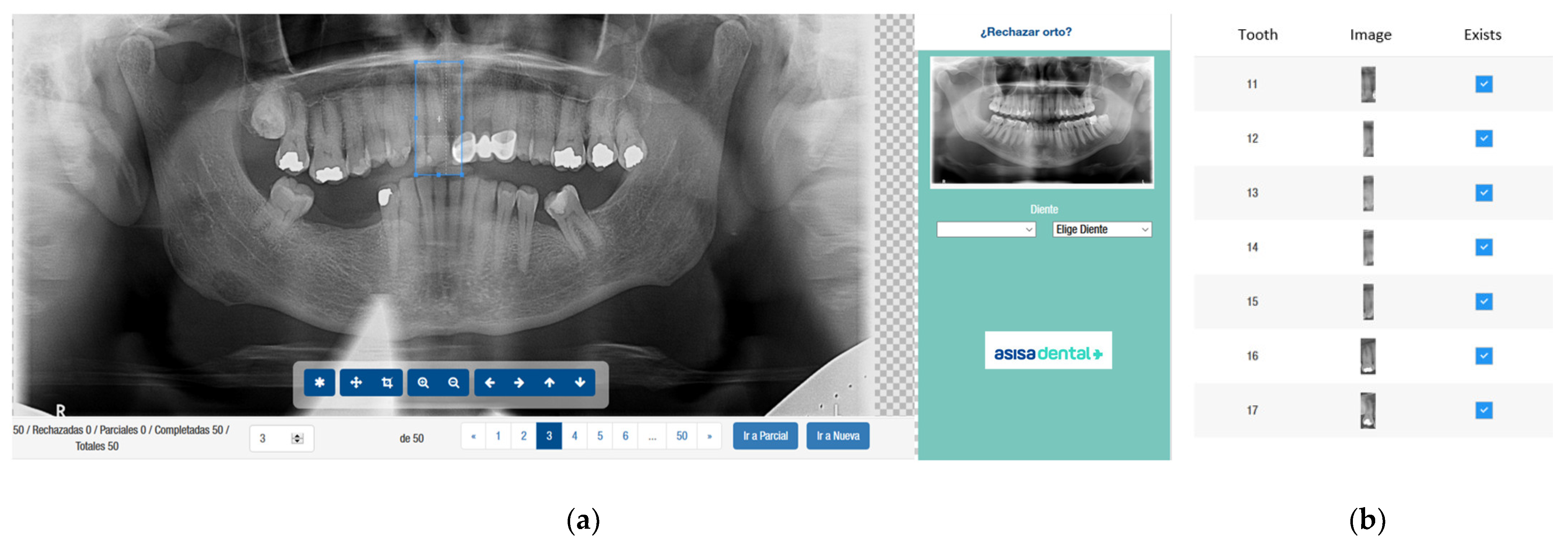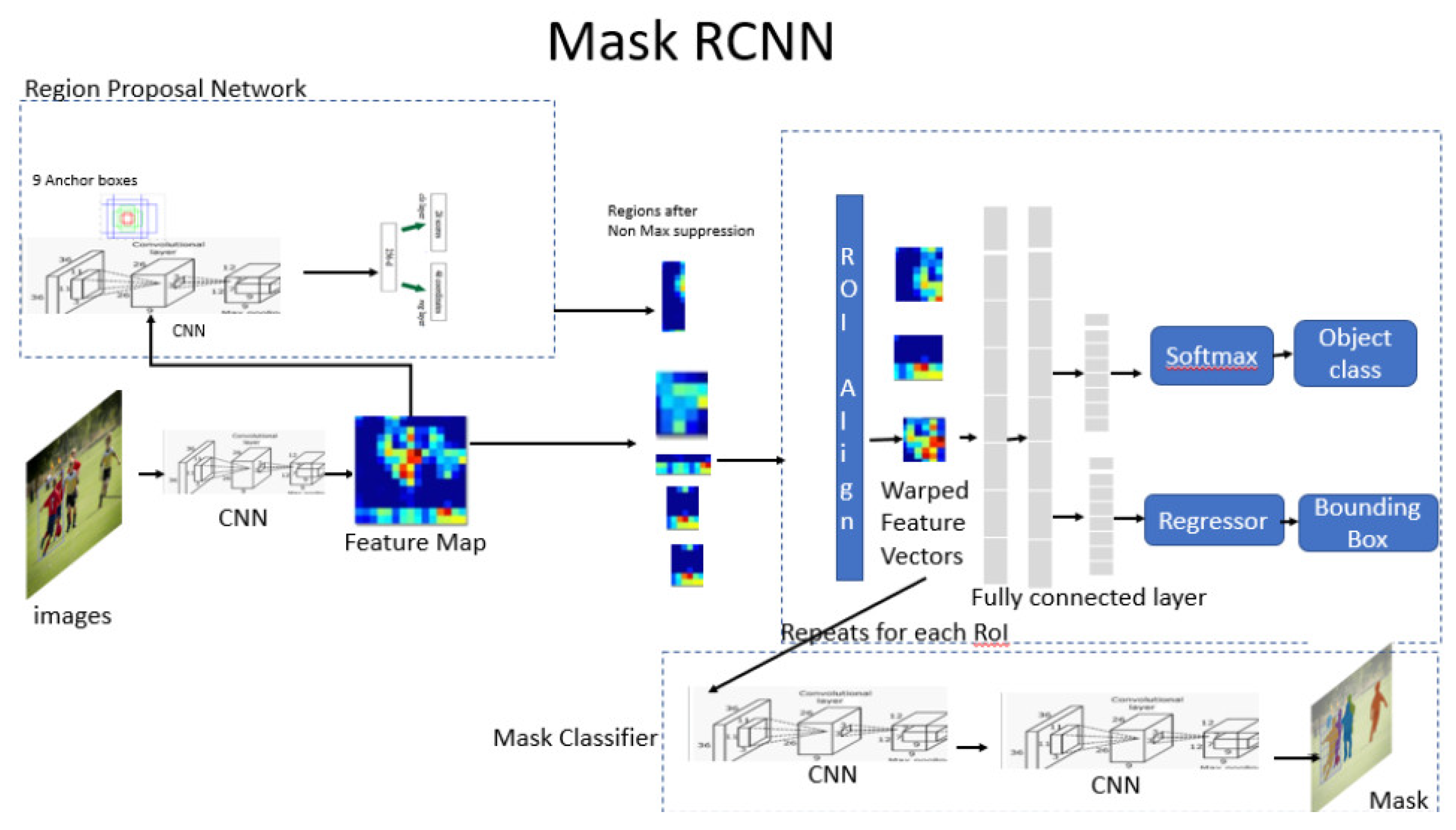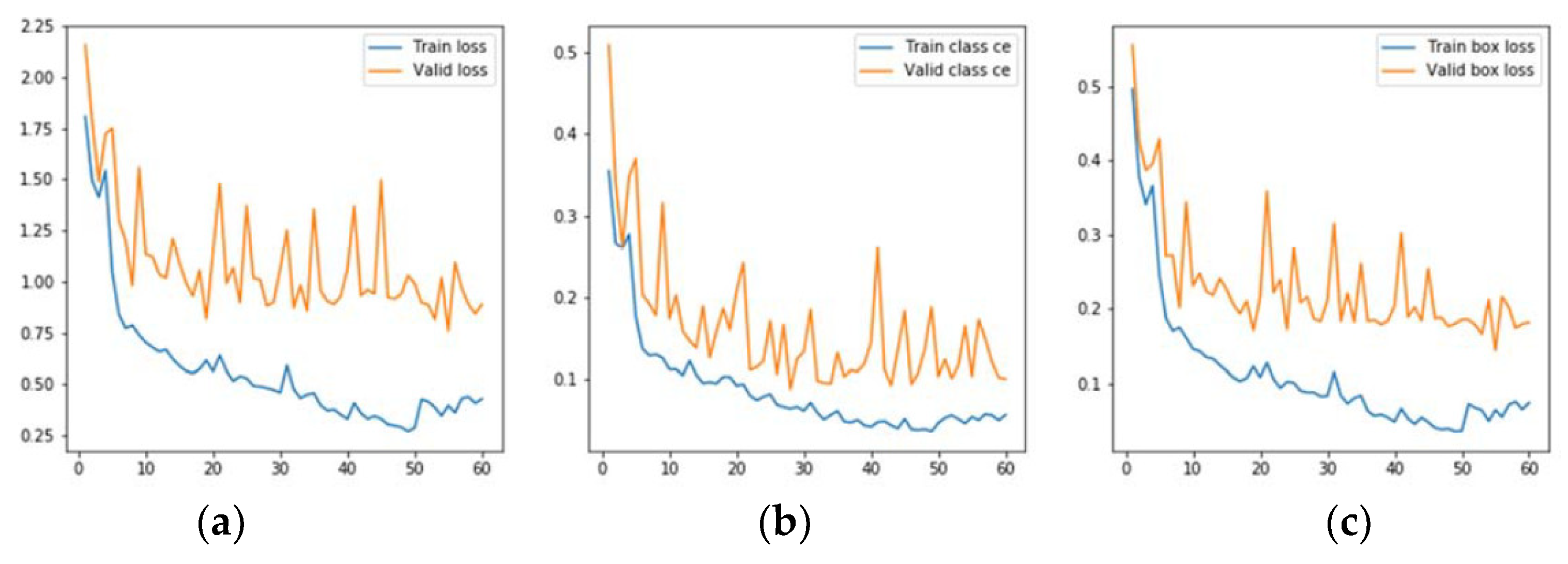A Validation Employing Convolutional Neural Network for the Radiographic Detection of Absence or Presence of Teeth
Abstract
1. Introduction
2. Materials and Methods
2.1. Study Design
2.2. Sample Size Calculation
2.3. Image Categorization
2.4. Image Dataset
2.5. CNN Architecture
3. Results
3.1. Image Categorization Results
3.2. Teeth Detection Results
3.3. Some Interesting Examples
3.4. Model Execution Examples
4. Discussion
5. Conclusions
Author Contributions
Funding
Institutional Review Board Statement
Informed Consent Statement
Conflicts of Interest
References
- Ngan, T.T.; Tuan, T.M.; Son, L.H.; Minh, N.H.; Dey, N. Decision Making Based on Fuzzy Aggregation Operators for Medical Diagnosis from Dental X-ray images. J. Med. Syst. 2016, 40, 280. [Google Scholar] [CrossRef] [PubMed]
- Wang, C.-W.; Huang, C.-T.; Lee, J.-H.; Li, C.-H.; Chang, S.-W.; Siao, M.-J.; Lai, T.-M.; Ibragimov, B.; Vrtovec, T.; Ronneberger, O.; et al. A benchmark for comparison of dental radiography analysis algorithms. Med. Image Anal. 2016, 31, 63–76. [Google Scholar] [CrossRef] [PubMed]
- Tuzoff, D.V.; Tuzova, L.N.; Bornstein, M.M.; Krasnov, A.S.; Kharchenko, M.A.; Nikolenko, S.I.; Sveshnikov, M.M.; Bednenko, G.B. Tooth detection and numbering in panoramic radiographs using convolutional neural networks. Dentomaxillofacial Radiol. 2019, 48, 20180051. [Google Scholar] [CrossRef] [PubMed]
- Chen, H.; Zhang, K.; Lyu, P.; Li, H.; Zhang, L.; Wu, J.; Lee, C.-H. A deep learning approach to automatic teeth detection and numbering based on object detection in dental periapical films. Sci. Rep. 2019, 9, 3840. [Google Scholar] [CrossRef] [PubMed]
- Kumar, R.; Khambete, N.; Priya, E. Extraoral periapical radiography: An alternative approach to intraoral periapical radiography. Imaging Sci. Dent. 2011, 41, 161. [Google Scholar] [CrossRef]
- Nardi, C.; Calistri, L.; Grazzini, G.; Desideri, I.; Lorini, C.; Occhipinti, M.; Mungai, F.; Colagrande, S. Is Panoramic Radiography an Accurate Imaging Technique for the Detection of Endodontically Treated Asymptomatic Apical Periodontitis? J. Endod. 2018, 44, 1500–1508. [Google Scholar] [CrossRef]
- Doi, K. Computer-aided diagnosis in medical imaging: Historical review, current status and future potential. Comput. Med. Imaging Graph. 2007, 31, 198–211. [Google Scholar] [CrossRef] [PubMed]
- Arik, S.Ö.; Ibragimov, B.; Xing, L. Fully automated quantitative cephalometry using convolutional neural networks. J. Med. Imaging 2017, 4, 014501. [Google Scholar] [CrossRef] [PubMed]
- Miki, Y.; Muramatsu, C.; Hayashi, T.; Zhou, X.; Hara, T.; Katsumata, A.; Fujita, H. Classification of teeth in cone-beam CT using deep convolutional neural network. Comput. Biol. Med. 2017, 80, 24–29. [Google Scholar] [CrossRef] [PubMed]
- Chen, M.; Decary, M. Artificial intelligence in healthcare: An essential guide for health leaders. Healthc. Manag. Forum 2020, 33, 10–18. [Google Scholar] [CrossRef]
- Schwalbe, N.; Wahl, B. Artificial intelligence and the future of global health. Lancet 2020, 395, 1579–1586. [Google Scholar] [CrossRef]
- Lin, P.L.; Lai, Y.H.; Huang, P.W. An effective classification and numbering system for dental bitewing radiographs using teeth region and contour information. Pattern Recognit. 2010, 43, 1380–1392. [Google Scholar] [CrossRef]
- LeCun, Y.; Bengio, Y.; Hinton, G. Deep learning. Nature 2015, 521, 436–444. [Google Scholar] [CrossRef] [PubMed]
- Zhang, K.; Wu, J.; Chen, H.; Lyu, P. An effective teeth recognition method using label tree with cascade network structure. Comput. Med. Imaging Graph. 2018, 68, 61–70. [Google Scholar] [CrossRef]
- Arbeláez, P.; Maire, M.; Fowlkes, C.; Malik, J. Contour Detection and Hierarchical Image Segmentation. IEEE Trans. Pattern Anal. Mach. Intell. 2011, 33, 898–916. [Google Scholar] [CrossRef]
- Li, S.; Fevens, T.; Krzyżak, A.; Li, S. An automatic variational level set segmentation framework for computer aided dental X-rays analysis in clinical environments. Comput. Med. Imaging Graph. 2006, 30, 65–74. [Google Scholar] [CrossRef]
- Li, Z.; Zhang, X.; Müller, H.; Zhang, S. Large-scale retrieval for medical image analytics: A comprehensive review. Med. Image Anal. 2018, 43, 66–84. [Google Scholar] [CrossRef] [PubMed]
- Bossuyt, P.M.; Reitsma, J.B.; Bruns, D.E.; Gatsonis, C.A.; Glasziou, P.P.; Irwig, L.; Lijmer, J.G.; Moher, D.; Rennie, D.; de Vet, H.C.W.; et al. STARD 2015: An updated list of essential items for reporting diagnostic accuracy studies. BMJ 2015, h5527. [Google Scholar] [CrossRef] [PubMed]
- Landis, J.R.; Koch, G.G. The Measurement of Observer Agreement for Categorical Data. Biometrics 1977, 33, 159. [Google Scholar] [CrossRef]
- Leite, A.F.; Van Gerven, A.; Willems, H.; Beznik, T.; Lahoud, P.; Gaêta-Araujo, H.; Vranckx, M.; Jacobs, R. Artificial intelligence-driven novel tool for tooth detection and segmentation on panoramic radiographs. Clin. Oral Investig. 2020. [Google Scholar] [CrossRef] [PubMed]
- Prados-Privado, M.; Villalón, J.G.; Martínez-Martínez, C.H.; Ivorra, C. Dental Images Recognition Technology and Applications: A Literature Review. Appl. Sci. 2020, 10, 2856. [Google Scholar] [CrossRef]
- Mahoor, M.H.; Abdel-Mottaleb, M. Classification and numbering of teeth in dental bitewing images. Pattern Recognit. 2005, 38, 577–586. [Google Scholar] [CrossRef]
- Aeini, F.; Mahmoudi, F. Classification and numbering of posterior teeth in bitewing dental images. In Proceedings of the 2010 3rd International Conference on Advanced Computer Theory and Engineering(ICACTE), Chengdu, China, 20–22 August 2010; IEEE: Piscataway Township, NJ, USA, 2010; pp. V6-66–V6-72. [Google Scholar]
- Betul Oktay, A. Tooth detection with Convolutional Neural Networks. In Proceedings of the 2017 Medical Technologies National Congress (TIPTEKNO), Trabzon, Turkey, 12–14 October 2017; pp. 1–4. [Google Scholar]
- Muramatsu, C.; Morishita, T.; Takahashi, R.; Hayashi, T.; Nishiyama, W.; Ariji, Y.; Zhou, X.; Hara, T.; Katsumata, A.; Ariji, E.; et al. Tooth detection and classification on panoramic radiographs for automatic dental chart filing: Improved classification by multi-sized input data. Oral Radiol. 2020. [Google Scholar] [CrossRef]
- Zanella-Calzada, L.; Galván-Tejada, C.; Chávez-Lamas, N.; Rivas-Gutierrez, J.; Magallanes-Quintanar, R.; Celaya-Padilla, J.; Galván-Tejada, J.; Gamboa-Rosales, H. Deep Artificial Neural Networks for the Diagnostic of Caries Using Socioeconomic and Nutritional Features as Determinants: Data from NHANES 2013–2014. Bioengineering 2018, 5, 47. [Google Scholar] [CrossRef]
- Bulman, J.S.; Osborn, J.F. Measuring diagnostic consistency. Br. Dent. J. 1989, 166, 377–381. [Google Scholar] [CrossRef] [PubMed]
- Jader, G.; Fontineli, J.; Ruiz, M.; Abdalla, K.; Pithon, M.; Oliveira, L. Deep Instance Segmentation of Teeth in Panoramic X-Ray Images. In 2018 31st SIBGRAPI Conference on Graphics, Patterns and Images (SIBGRAPI); IEEE: Piscataway Township, NJ, USA, 2018; pp. 400–407. [Google Scholar]
- Zhao, Q.; Kong, P.; Min, J.; Zhou, Y.; Liang, Z.; Chen, S.; Li, M. A review of deep learning methods for the detection and classification of pulmonary nodules. Sheng Wu Yi Xue Gong Cheng Xue Za Zhi 2019, 36, 1060–1068. [Google Scholar] [CrossRef] [PubMed]
- İnik, Ö.; Ceyhan, A.; Balcıoğlu, E.; Ülker, E. A new method for automatic counting of ovarian follicles on whole slide histological images based on convolutional neural network. Comput. Biol. Med. 2019, 112, 103350. [Google Scholar] [CrossRef]
- Ding, L.; Liu, G.-W.; Zhao, B.-C.; Zhou, Y.-P.; Li, S.; Zhang, Z.-D.; Guo, Y.-T.; Li, A.-Q.; Lu, Y.; Yao, H.-W.; et al. Artificial intelligence system of faster region-based convolutional neural network surpassing senior radiologists in evaluation of metastatic lymph nodes of rectal cancer. Chin. Med. J. (Engl.) 2019, 132, 379–387. [Google Scholar] [CrossRef] [PubMed]
- Schwendicke, F.; Elhennawy, K.; Paris, S.; Friebertshäuser, P.; Krois, J. Deep Learning for Caries Lesion Detection in Near-Infrared Light Transillumination Images: A Pilot Study. J. Dent. 2019, 103260. [Google Scholar] [CrossRef] [PubMed]
- Raith, S.; Vogel, E.P.; Anees, N.; Keul, C.; Güth, J.-F.; Edelhoff, D.; Fischer, H. Artificial Neural Networks as a powerful numerical tool to classify specific features of a tooth based on 3D scan data. Comput. Biol. Med. 2017, 80, 65–76. [Google Scholar] [CrossRef]










| Number of Images | Maximum Resolution | Minimum Resolution | Mean Resolution | |
|---|---|---|---|---|
| DICOM 8 bit | 5121 | 3121 × 1478 | 649 × 490 | 2699 × 1468 |
| DICOM 12 bit | 2669 | 304 × 2298 | 2105 × 1528 | 2682 × 1459 |
| Matterport Configuration Class | |
|---|---|
| Name | CoreDXnet |
| Backbone | Resnet101 |
| Batch size | 2 |
| Images per GPU | 2 |
| Learning rate | 0.006 |
| Steps per epoch | 200 |
| Total epochs | 60 |
| Total steps | 200 |
Publisher’s Note: MDPI stays neutral with regard to jurisdictional claims in published maps and institutional affiliations. |
© 2021 by the authors. Licensee MDPI, Basel, Switzerland. This article is an open access article distributed under the terms and conditions of the Creative Commons Attribution (CC BY) license (http://creativecommons.org/licenses/by/4.0/).
Share and Cite
Prados-Privado, M.; García Villalón, J.; Blázquez Torres, A.; Martínez-Martínez, C.H.; Ivorra, C. A Validation Employing Convolutional Neural Network for the Radiographic Detection of Absence or Presence of Teeth. J. Clin. Med. 2021, 10, 1186. https://doi.org/10.3390/jcm10061186
Prados-Privado M, García Villalón J, Blázquez Torres A, Martínez-Martínez CH, Ivorra C. A Validation Employing Convolutional Neural Network for the Radiographic Detection of Absence or Presence of Teeth. Journal of Clinical Medicine. 2021; 10(6):1186. https://doi.org/10.3390/jcm10061186
Chicago/Turabian StylePrados-Privado, María, Javier García Villalón, Antonio Blázquez Torres, Carlos Hugo Martínez-Martínez, and Carlos Ivorra. 2021. "A Validation Employing Convolutional Neural Network for the Radiographic Detection of Absence or Presence of Teeth" Journal of Clinical Medicine 10, no. 6: 1186. https://doi.org/10.3390/jcm10061186
APA StylePrados-Privado, M., García Villalón, J., Blázquez Torres, A., Martínez-Martínez, C. H., & Ivorra, C. (2021). A Validation Employing Convolutional Neural Network for the Radiographic Detection of Absence or Presence of Teeth. Journal of Clinical Medicine, 10(6), 1186. https://doi.org/10.3390/jcm10061186





